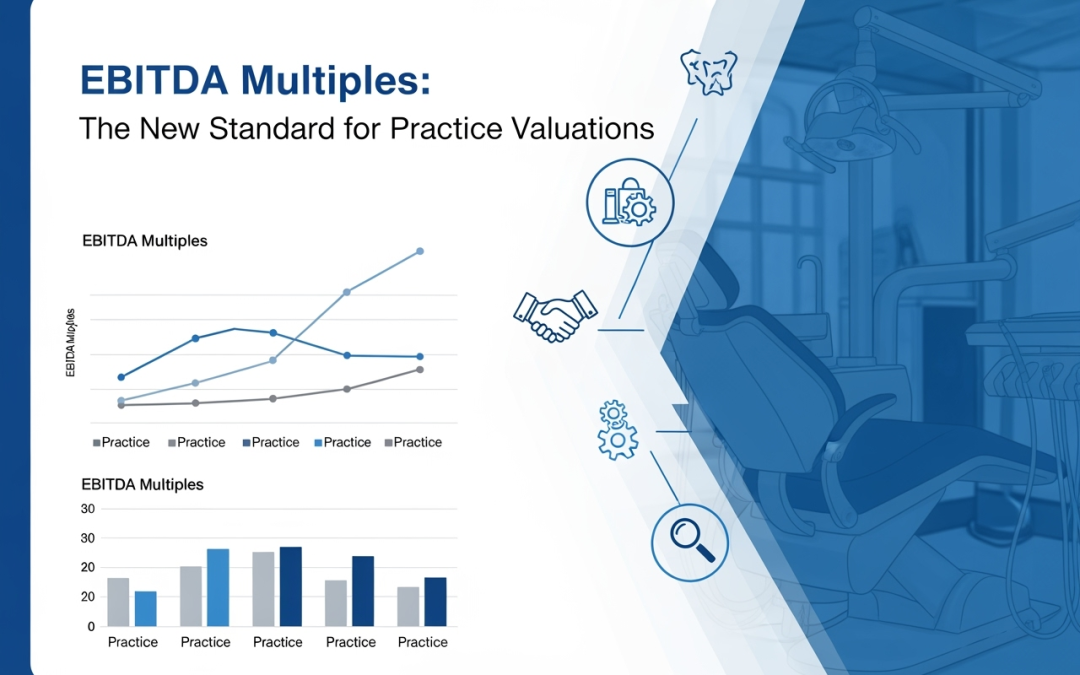Other Articles in this series:
1. What’s My Dental Practice Worth?
2. EBITDA Multiples: The New Standard for Practice Valuations
3. Key Factors That Determine Your Practice Value
4. Maximizing Your Practice Value: EBITDA Optimization Strategies
In Article 1 of this series, we explored the three core approaches to dental practice valuation and why modern methods have replaced outdated rules of thumb. Today, we’re diving deep into the methodology that has revolutionized practice valuations: EBITDA multiples.
If you’re still thinking about your practice worth in terms of revenue percentages, you’re using math that could cost you hundreds of thousands of dollars. The shift to EBITDA-based valuations represents a fundamental change in how buyers evaluate practices, and understanding this change is crucial for maximizing your practice value.
EBITDA multiples have become the gold standard because they focus on what matters most to buyers: your practice’s ability to generate consistent, predictable cash flow. This approach rewards well-managed practices while exposing operational inefficiencies that reduce value.
Understanding EBITDA in Dental Practices
EBITDA stands for Earnings Before Interest, Taxes, Depreciation, and Amortization. For dental practices, EBITDA represents the cash flow available to service debt, reinvest in the practice, and provide return to the owner.
Calculating Your Practice’s EBITDA:
Start with your net income, then add back:
– Interest expenses
– Tax expenses
– Depreciation on equipment and improvements
– Amortization of intangible assets
– Owner compensation adjustments (normalized to market rates)
– One-time or non-recurring expenses
Example EBITDA Calculation:
– Net Income: $200,000
– Owner Compensation Adjustment: +$150,000
– Interest: +$15,000
– Taxes: +$45,000
– Depreciation: +$25,000
– Total EBITDA: $435,000
Healthy EBITDA Margins
Well-managed dental practices typically achieve EBITDA margins of 25-40% of gross revenue. Practices below 20% may face valuation challenges, while those above 40% often command premium multiples.
For a practice generating $1 million in annual revenue:
– 20% EBITDA = $200,000 (needs improvement)
– 30% EBITDA = $300,000 (healthy performance)
– 40% EBITDA = $400,000 (excellent performance)
The difference between 20% and 40% EBITDA margins can mean hundreds of thousands of dollars in practice value when multiples are applied.
How EBITDA Multiples Work
EBITDA multiples typically range from 3x to 7x for dental practices, with most transactions falling in the 4-6x range. The multiple applied to your practice depends on various factors we’ll explore in detail.
Real-World Examples:
Practice A: $300,000 EBITDA
– At 3x multiple = $900,000 value
– At 5x multiple = $1,500,000 value
– At 7x multiple = $2,100,000 value
Practice B: $500,000 EBITDA
– At 4x multiple = $2,000,000 value
– At 6x multiple = $3,000,000 value
The difference between a 3x and 7x multiple is dramatic – over $1.2 million for a practice with $300,000 EBITDA. This explains why optimizing the factors that drive higher multiples is so crucial for practice owners.
Why EBITDA Multiples Work Better Than Revenue Multiples:
Revenue multiples don’t account for profitability differences:
– Two $1M practices might have $200K vs $400K EBITDA
– Revenue multiple treats them equally
– EBITDA multiple properly values the more profitable practice
EBITDA multiples reflect operational efficiency:
– Reward practices with strong cost management
– Recognize technology and system investments
– Value sustainable competitive advantages
Buyers focus on cash flow, not gross revenue:
– EBITDA represents available cash flow
– Buyers can model debt service and returns
– More accurate reflection of acquisition value
What Drives Higher Multiples
Several key factors influence whether your practice receives a 3x or 7x EBITDA multiple. Understanding these factors helps you identify opportunities to increase your valuation.
Practice Size and Consistency
Larger practices with consistent EBITDA performance typically command higher multiples. Buyers value predictability and scale, viewing larger practices as less risky investments.
– Practices with EBITDA above $500,000 often receive premium multiples
– Consistent year-over-year performance reduces buyer risk
– Documented financial systems and reporting add credibility
Growth Trends and Market Position
Practices demonstrating growth potential and strong market positions attract higher multiples. Buyers pay premiums for practices positioned for continued success.
– Positive EBITDA growth over 3-5 years
– Strong new patient acquisition and retention
– Competitive advantages in local market
– Expansion opportunities and scalability
Operational Efficiency and Systems
Well-documented systems and efficient operations command higher multiples because they demonstrate transferability and reduced management risk.
– Documented procedures and training programs
– Technology integration and automation
– Strong staff retention and cross-training
– Quality control and patient satisfaction metrics
Market Conditions and Buyer Competition
External factors also influence multiples, including local market dynamics and buyer competition.
– Multiple qualified buyers can drive up multiples
– Strong local demographics and growth
– Limited competition from other practices for sale
– Favorable financing conditions
HPA’s EBITDA Optimization Approach
At Health Professionals Alliance, we’ve developed systematic approaches to help practices optimize their EBITDA and command higher valuation multiples. Our strategies focus on both cost reduction and revenue enhancement.
Real-World Results:
One HPA member practice achieved $63,900 in annual savings through strategic partnerships alone. At a 5x EBITDA multiple, this translates to $319,500 in added practice value – from cost optimization alone.
These savings came from:
– Group purchasing power for supplies and equipment
– Patient surcharging strategies for credit card processing
– Optimized service provider agreements
– Technology solutions that improve efficiency
Our Navigator Program provides ongoing support to help practices identify and implement EBITDA optimization opportunities systematically. Rather than leaving you to figure it out alone, we provide the guidance and partnerships needed to achieve meaningful improvements.
Coming Up in Article 3: “Key Factors That Determine Your Practice Value” – We’ll explore the specific operational, financial, and market factors that influence your EBITDA multiple and which ones you can control.
Contact Health Professionals Alliance today for your complimentary discovery call:- SCHEDULE A 30-MINUTE MEETING– Phone: 855.339.7151
– Email: admin@hpamembers.com
– Website: www.hpamembers.com
Understanding your current EBITDA and optimization potential is the first step toward maximizing your practice worth using today’s valuation standards.

